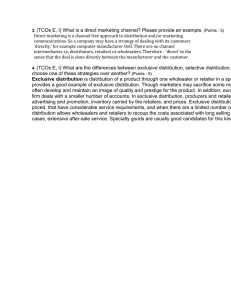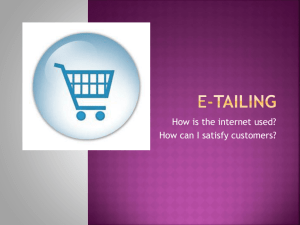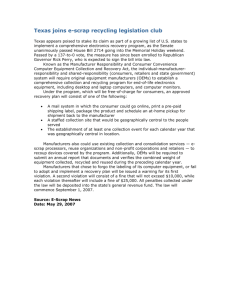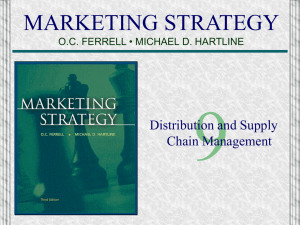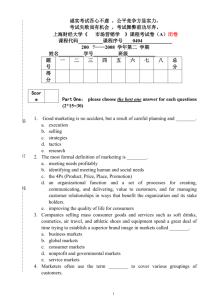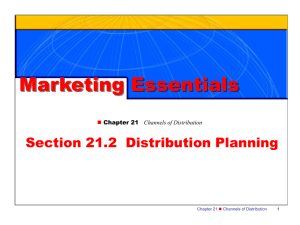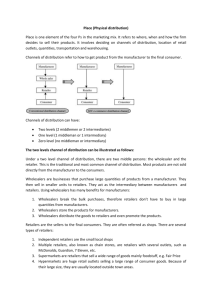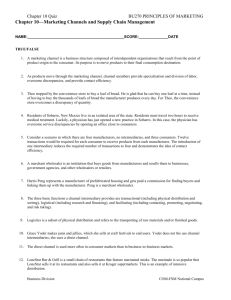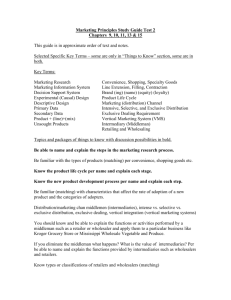Chapter 8: Distribution and Supply Chain Management
advertisement
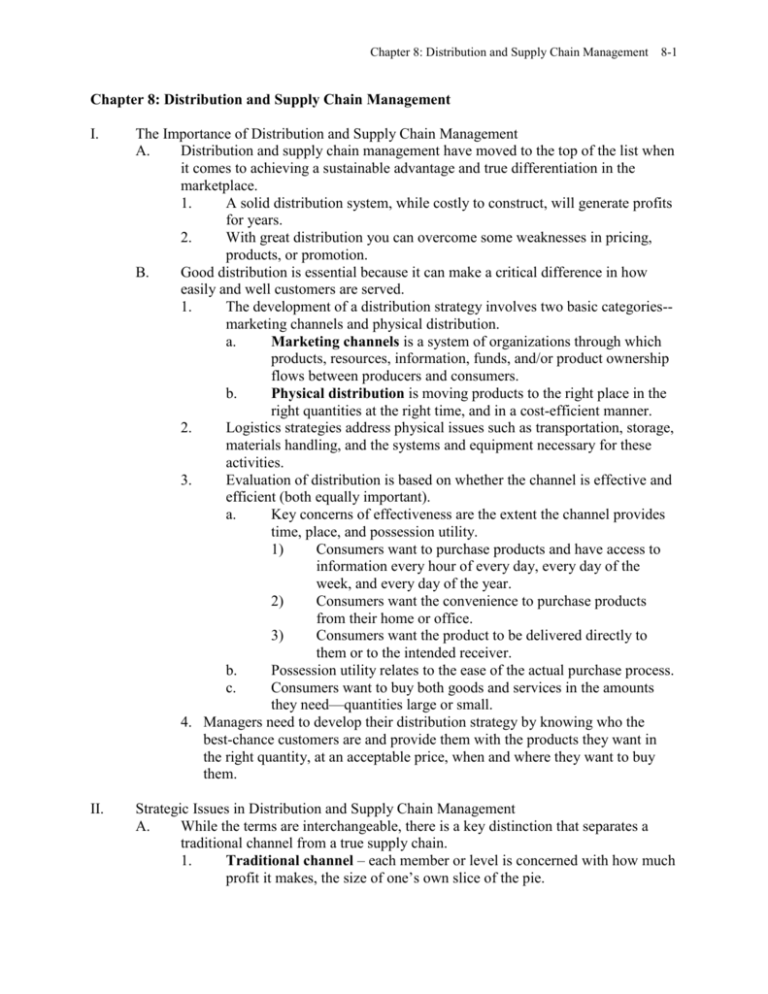
Chapter 8: Distribution and Supply Chain Management 8-1 Chapter 8: Distribution and Supply Chain Management I. The Importance of Distribution and Supply Chain Management A. Distribution and supply chain management have moved to the top of the list when it comes to achieving a sustainable advantage and true differentiation in the marketplace. 1. A solid distribution system, while costly to construct, will generate profits for years. 2. With great distribution you can overcome some weaknesses in pricing, products, or promotion. B. Good distribution is essential because it can make a critical difference in how easily and well customers are served. 1. The development of a distribution strategy involves two basic categories-marketing channels and physical distribution. a. Marketing channels is a system of organizations through which products, resources, information, funds, and/or product ownership flows between producers and consumers. b. Physical distribution is moving products to the right place in the right quantities at the right time, and in a cost-efficient manner. 2. Logistics strategies address physical issues such as transportation, storage, materials handling, and the systems and equipment necessary for these activities. 3. Evaluation of distribution is based on whether the channel is effective and efficient (both equally important). a. Key concerns of effectiveness are the extent the channel provides time, place, and possession utility. 1) Consumers want to purchase products and have access to information every hour of every day, every day of the week, and every day of the year. 2) Consumers want the convenience to purchase products from their home or office. 3) Consumers want the product to be delivered directly to them or to the intended receiver. b. Possession utility relates to the ease of the actual purchase process. c. Consumers want to buy both goods and services in the amounts they need—quantities large or small. 4. Managers need to develop their distribution strategy by knowing who the best-chance customers are and provide them with the products they want in the right quantity, at an acceptable price, when and where they want to buy them. II. Strategic Issues in Distribution and Supply Chain Management A. While the terms are interchangeable, there is a key distinction that separates a traditional channel from a true supply chain. 1. Traditional channel – each member or level is concerned with how much profit it makes, the size of one’s own slice of the pie. Chapter 8: Distribution and Supply Chain Management Supply chain – concern is the share of the market the entire channel captures. [Exhibit 8.1] Marketing Channel Structures 1. There are many strategic options for the structure of a channel of distribution, and these strategies are often complex and very costly to implement. a. A good distribution strategy is essential because once a channel is selected and commitments are made, distribution often becomes highly inflexible due to long-term contracts, investments, and commitments between channel members. b. There are three basic structural options of distribution in terms of the amount of market coverage and level of exclusivity between vendor and retailer. 1) Exclusive distribution gives one merchant or outlet the sole right to sell a product within a defined geographic region. a) Commonly associated with prestige products. b) Targets a single, well-defined segment. 2) Selective distribution gives several outlets the right to sell a product in a defined geographic region. a) Customers need the opportunity to comparison shop. b) After-sale services are important. 3) Intensive distribution makes a product available in the maximum number of outlets in each region to gain as much exposure and as many sales opportunities as possible. a) Closely associated with consumer convenience goods. b) Manufacturer gives up control in order to get as much visibility as possible. A key consideration in making strategic decisions about the structure of one’s marketing channel is to know the value components target customers will see as attractive as they make selections. 1. Included here are information communication and sales, after-sale service, delivery, enhancements, and solution development. 2. Solution development involves the combination of complementary products that yield a greater overall value. Power and Conflict in the Supply Chain 1. The implementation of a relationship driven by supply chain management is difficult to achieve unless there is a fundamental change in how distribution channel members work together. a. A change from a “win-lose” competitive attitude to a “win-win” collaborative approach. b. Information flows move from an as need basis to open, honest, and frequent communications. 2. B. C. D. 8-2 Chapter 8: Distribution and Supply Chain Management 8-3 c. 2. 3. III. Points of contact expand from one-on-one to multiple interfaces at all levels. The sources of power or influence that are utilized also change with the move from a traditional channel to a collaborative supply chain approach. a. Power, or influence, can be defined as the ability to get other parties to do or say something they would otherwise not do or say. b. Channel power can be broken down into a limited set: 1) Legitimate power—This power source has to do with the firm’s position in the marketing channel. 2) Reward power—The ability to help other parties reach their goals and objectives. 3) Coercive power—Is the ability to take positive outcomes away from, or even to inflict punishment on, another channel member. 4) Information power—Having and sharing knowledge. 5) Referent power—Like doing business with the other party or organization. c. Whether the problems that naturally materialize in a marketing channel are confronted successfully is dependent on the successful development, communication, and utilization of information. A further example of the move to form collaborative supply chains is the ongoing and highly successful initiative called category management. Category management should be: [Exhibit 8.3] a. Customer driven: Manufacturers and wholesalers should make all decisions with a concern for the challenges backing retailers in the channel. b. Strategically driven: The relationship between the parties should be driven by a strategic plan to advance the relationship and to advance the outcomes for the parties involved. c. Multifunctional: Contact points should include areas such as finance, logistics, quality control, and facilities management. d. Financially based: Solid financial targets should be set and met in terms of profitability and hard and soft cost management. e. Systems dependent: Systems should be designed and put in place to support the activities of the relationship. Trends in Marketing Channels A. Distribution activities have changed as a result of increased distribution from producers directly to consumers. 1. The move toward direct marketing has led to the elimination of some retailers from marketing channels. 2. While channels members may go away the functions those members perform must continue to be fulfilled. B. Distribution strategy is also changing as a result of the growing power of discount mass merchandise retailers which have gained increasing power relative to their suppliers. Chapter 8: Distribution and Supply Chain Management C. D. IV. 8-4 Distribution strategies often need multiple channels to reach various markets. Multiple channels enable a producer to offer two or more lines of the same merchandise through two or more means, thus increasing sales coverage. 1. It spreads marketing mix resources across two or more channels, instead of focusing them on just one. 2. It can also create channel conflict, particularly when the target segments are not clearly defined and distinct for each channel. Order Fulfillment and e-Commerce 1. Significant advances in information processing and computer-to-computer communications have made possible the introduction of new ways to place and fill orders. 2. E-fulfillment is based on a true partnership between marketing and logistics. a. Growth in e-commerce has been sparked by consumer demands for convenience and safety. b. Faster, better, and cheaper is what business customers and consumers alike have been demanding. c. Ownership of personal computers and Internet access has become a critical channel component for both manufacturers and retailers to consider. Legal and Ethical Issues in Distribution Strategy A. Like every other aspect of marketing strategy, distribution decisions must be made with an eye toward ethical and legal considerations. B. Counterfeit products abound today, particularly in the areas of clothing, audio and video products, and computer software.. C. Manufacturers are not the only ones that get hurt when counterfeit products are purchased. 1. Governments are affected by the loss of tax revenues. 2. Jobs are lost at legitimate companies. 3. Consumers are affected by the quality of counterfeit products. 4. Counterfeiting has become a convenient way for organized crime to support its activities. D. The Counterfeit Library Web site provides guidelines to reduce the probability of purchasing counterfeit items online. 1. Look for sites that accept credit cards. Banks and credit card companies conduct checks on such firms. 2. Avoid sending cash whenever possible. 3. Check out any unfamiliar source with friends and trusted individuals. 4. Avoid buying from contacts made via discussion groups or chat rooms. 5. Beware of purchase price, it may be too good to be true. E. An exclusive arrangement benefits a manufacturer by requiring that an intermediary, such as a wholesaler, broker, agent, or retailer, not carry or represent products from any of the manufacturer’s competitors. 1. Not all exclusive dealing agreements are legal. There are three tests that determine their validity. Chapter 8: Distribution and Supply Chain Management a. b. c. 8-5 First, the arrangement cannot block competitors from 10 percent or more of the overall market. Second, the sales revenue involved can’t be sizable. Finally, the manufacturer can’t be much larger than the intermediary. Questions for Discussion 1. What do you see as the major differences you have experienced in buying a product through a retail store, a manufacturer store, a catalog, and an eCommerce source? What have some retailers in your area done to justify their ongoing presence in the channel? 2. Talk about what makes a product something you would go to great lengths to get, thus supporting the use of an exclusive distribution strategy by a manufacturer. What items do you expect to find at any quick shop or grocery store? How much more knowledgeable are the salespeople in explaining the product at an exclusive distribution location versus an extensive distribution location? Why is this the case? 3. Some manufacturers and retailers advertise that you should shop with them because “We eliminate the middle-man.” Evaluate this comment in light of the functions that must be performed in a marketing channel. Does a channel with fewer members always deliver cheaper products to customers? Defend your position.
